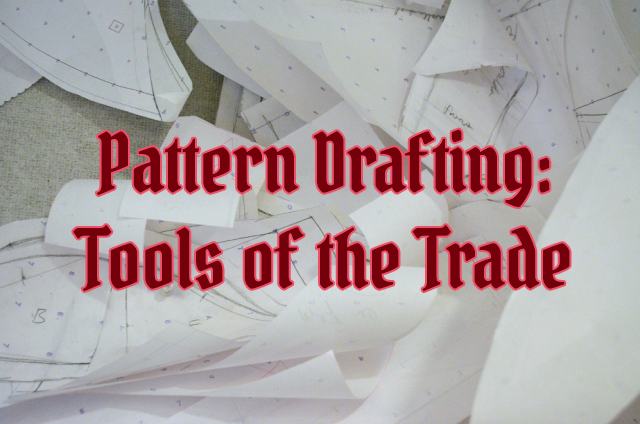As many of you know I make the majority of my clothing myself and I have been sewing now for over a decade. I first learned to draft patterns (and how to drape too!) during my freshman year of design school back in 2009, and I have never looked back! After having been restricted to commercial patterns for my early years of sewing, nothing felt better than being able to draft anything my mind could dream up onto paper. Move the darts into a princess line seam instead? Change a neckline? Add a sleeve? With some basic pattern drafting skills, a whole new world of possibilities open up!
So what do I use to do my pattern drafting? The most basic of tools are paper, a pencil, and scissors of course, but upgrading these basics from what you have lying around to real deal equipment makes the experience so much nicer! My favorite pattern drafting tools include:
1) A flexible clear ruler. These bendy (but not too bendy) clear rulers usually have red lines and mine as you can see below is 18 inches; though when I studied abroad I did have a different one that was centimeters instead of inches. This is my main ruler for drafting, and I actually have two of them lying around my sewing room as I like them that much!
2) Alphanumeric paper. Of course hypothetically any paper could be used for pattern drafting, but alphanumeric paper (gridded with you guessed it, letters and numbers) is my favorite for both the general 1"-ish (it's not precisely perfect but it'll do) grid and for its light weight. Tissue paper rips too easily, poster-board and the like are too thick, alphanumeric paper is just right.
3) Big paper shears. Why have such ludicrously large paper scissors? Well because they make cutting through any weight paper a breeze and are frankly easier to use on wide width paper when your cutting it off the roll. The shorter blades make them easy to use on curves too, plus they can probably double as a weapon in most zombie apocalypse scenarios (just kidding).
4) Curved rulers. Nothing better for hip and arm hole curves than these standardized curved rulers sold for just this purpose. Find them online or at most fabric shops and keep them on hand for smoothing out curves.
5) Pencils. Obviously, of course. Also a larger eraser for when you change your mind :)
6) Scotch tape. I like regular old plastic scotch tape for putting together and changing my patterns on the fly.
7) Weights of some kind. I use my brick-like tape dispenser and paper shears when I get desperate, but they do sell specific pattern weights for holding down your paper when it wants to roll back up while you attempt to draft on it.
8) Pattern Making for Fashion Design by Helen Joseph Armstrong. Of course I am still no expert on pattern drafting so I pull out my textbook from university from time to time when I want to know how to properly add ease here, or move darts there, or change a style line I'm not familiar with. It's good to have resources on hand so you don't have to break the flow searching for hours on the internet to see how something is done. There are dozens of pattern drafting books out there, but this is the one I have always used and I do quite like it.
Of course there are a bunch of other tools out there, from tracing wheels to special carbon paper, but this relatively short list of tools are the ones I have in constant use myself. I hope to start sharing more about how I make and transform my patterns here on the blog in the near future, so I figured going over some very basic information today would be a good start! Do any of you draft your own sewing patterns? If so, what are your favorite tools for doing so?





I'd love it if you could do a tutorial on draping or or how to create off a a block!
ReplyDeleteI definitely want to do more patterning tutorials in the future so stay tuned!
DeleteMy favorite is the Pattern Design book, and my curved metal rulers. I need to get some paper shears, maybe a christmas present to myself!
ReplyDeleteAnd we've been sewing about the same time, how exciting is that? <3
Carla, Tiny Angry Crafts
My shears came with my freshman year class kit that we were required to buy for class, it was like Christmas getting that kit! So many sewing goodies :)
DeleteI use vase weights that I bought from the dollar store for pattern weights. Mine are star shaped, glass, and with a flat bottom. I also had a student make me pattern weights, using small tiles that she wrapped in brightly colored duct tape.
ReplyDeleteBut I've def used the "anything around" approach too. :)
Tegan
Vase weights are a great idea, I need to get something because using the tape dispenser or whichever scissors are closest gets old!
Delete